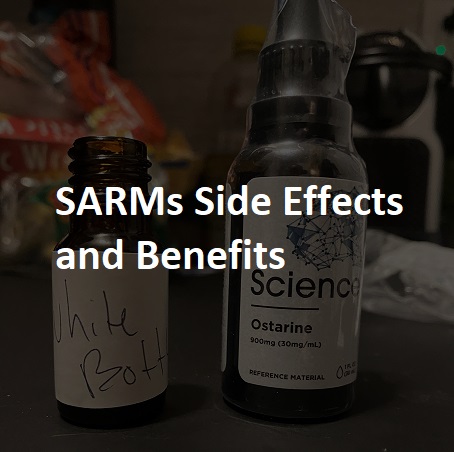SARMs: Side Effects, Benefits, Legal Status, and More
 Disclaimer: Only researchers are authorized to administer SARMs, as they are not FDA-approved for cosmetic use and may have adverse effects. Dr. Touliatos is available for consultation should readers have any questions or concerns.
Disclaimer: Only researchers are authorized to administer SARMs, as they are not FDA-approved for cosmetic use and may have adverse effects. Dr. Touliatos is available for consultation should readers have any questions or concerns.
SARMs (selective androgen receptor modulators) are a new generation of anabolic compounds synthesized with the intention of becoming a superior medicine to anabolic steroids.
Scientists’ main objective when formulating SARMs was to achieve a high binding affinity to the androgen receptor with tissue selectivity, thus mimicking the muscle-building effects of anabolic steroids but without the same degree of side effects.
Contents
SARMs are currently being studied as a potential treatment for cachexia, osteoporosis, cancer, sexual dysfunction, Alzheimer’s disease, and multiple sclerosis.
Several anabolic-androgenic steroids (AAS) have demonstrated effectiveness in treating the aforementioned health conditions while maintaining an acceptable level of safety:
These three compounds have been FDA-approved in medicine and are being prescribed to millions of patients worldwide.
However, anabolic steroids are not the perfect medicine, with them having the potential to cause:
- Cholesterol fluctuations
- Benign prostate enlargement
- Erythrocytosis
- Gynecomastia
- Low testosterone
- Virilization
- Peripheral edema
The objective of SARMs is to inhibit the androgenic, estrogenic, and cardiovascular side effects associated with anabolic steroids through the mechanism of tissue selectivity. However, the transcriptional activation of SARMs’ tissue selectivity is not yet fully understood. Thus, in practice, we still see SARMs causing some unpleasant side effects, similar to anabolic steroids. Until further human trials are conducted, SARMs are only to be utilized as research chemicals.
SARMs are very popular among the bodybuilding community, often being perceived as a safe version of anabolic steroids. However, this hypothesis is yet to be confirmed and is somewhat controversial, based on existing research and our experience presented in this article.
Safety evaluation
The production of SARMs dates back to the 1940s, with these early chemicals being derivatives of testosterone, known as steroidal SARMs.
Fast-forward to the late 1990s, and non-steroidal SARMs arrived on the scene, which is what bodybuilders refer to as SARMs today. Due to these compounds being recent discoveries, their effects are largely unknown and consequently under investigation.
As SARMs’ safety is not yet fully understood, they are not FDA-approved for human use. In 2017, the FDA labeled SARMs as potentially dangerous (1) and warned the public regarding their use.
The FDA also suggested that there is evidence of SARMs causing liver and cardiovascular issues in users after short-term use. They further stated that the long-term side effects of SARMs remain unknown.
A limited investigation has shown that only 52% of SARM products being sold on the internet actually contained the SARM listed on the label. Researchers also found that 39% of SARM products contain another unapproved substance, increasing safety concerns (2).
Dr. Thomas O’Connor has hypothesized SARMs to be more dangerous than anabolic steroids, based on 10 years’ worth of anecdotal evidence and the analyses of 2,000 laboratory tests from patients who have taken SARMs.
Legal status
SARMs are currently legal to buy and sell as research chemicals. This is why they are commonly sold in liquid form, i.e., as a suitable method of administration for rodents.
However, as bodybuilders are becoming increasingly aware of SARMs’ potential anabolic effects, companies have started selling SARMs in capsule form, a favorable administration method for humans.
Complications with the law can arise when manufacturers label SARMs as dietary supplements for humans due to a lack of FDA approval. Supplement companies are also forbidden from describing their benefits, which are yet to be medically concluded.
SARMs benefits
Muscle hypertrophy and strength
It is already evident that SARMs can stimulate muscle hypertrophy and strength. However, early human trials suggest SARMs may only possess mild anabolic properties compared to anabolic steroids (3).
- In this study, participants on SARMs gained 1–1.5 kg of fat-free mass over a 4–6-week period.
- In contrast, those on testosterone enanthate gained 5–7 kg of fat-free mass on 300 and 600 mg doses per week.
Fat loss
Stimulation of the androgen receptor increases lipolysis, enabling users to burn notable amounts of subcutaneous fat. SARMs, therefore, not only add lean muscle tissue but can also simultaneously increase muscle tone and definition.
More socially accepted
We find there is less social stigma attached to SARMs due to them being relatively unknown and less taboo versus anabolic steroids. This is despite anabolic steroids previously being routinely prescribed to bodybuilders in the 1960s by medical doctors before their side effects became more obvious.
No injections are required
SARMs are predominantly administered orally as a liquid, thus eliminating the risk of contaminated needles or improper injection techniques that may lead to paralysis.
Women are less likely to experience masculinization
We find SARMs do not typically cause virilization effects in women from low-to-moderate dosages due to weak levels of androgenicity via the mechanism of tissue selectivity. This makes SARMs a more suitable option for women compared to many anabolic steroids.
However, as SARMs are currently in the investigational stage, it may be safer for women to opt for female-friendly steroids that have been thoroughly researched, such as:
- Anavar
- Primobolan
- Deca Durabolin
The above compounds are known to prevent masculinization in women.
A potential alternative treatment for osteoporosis
Anabolic steroids increase bone mineral density (BMD). A lack of BMD significantly increases the risk of fractures and disability.
SARMs not only improve bone mineral density but also enhance bone mechanical strength, providing a potentially more optimal treatment for those suffering from osteoporosis.
SARMs side effects
Gynecomastia and hair loss
SARMs inhibit 5-alpha reductase enzyme activity; thus, no direct conversion to estrogen or DHT occurs.
Therefore, in theory, bodybuilders on SARMs would experience increases in lean muscle without the risk of gynecomastia or hair loss.
However, in practice, we observe cases of gynecomastia and male pattern baldness from SARM users.
The reason estrogenic and androgenic side effects can occur on SARMs is that a person’s natural testosterone binds to the androgen receptor (AR). However, SARMs interfere with this process, competing with an individual’s natural testosterone for binding to the AR.
SARMs have a significantly higher binding affinity than natural testosterone and thus will triumph in this contest, consequently leaving free testosterone more readily available to convert to estrogen and DHT. Thus, SARMs indirectly cause higher estrogen and DHT levels, responsible for these adverse effects.
Arimistane, or androsta-3,5-diene-7,17-dione, is a mild aromatase inhibitor that bodybuilders may utilize during SARM cycles to prevent gynecomastia and other estrogenic effects.
Other AIs, such as aromasin, letrozole, or anastrozole, are commonly administered during steroid cycles. However, such AIs can be excessively potent for SARMs, causing strong estrogen deficiencies as opposed to preventing excessive levels.
Testosterone suppression
SARMs can lower FSH and LH via excessive binding to the AR receptor, causing a decrease in natural testosterone levels.
Different levels of suppression often depend on the SARM utilized, causing some users to administer post-cycle therapies (PCT).
In our experience, here is how the most popular SARMs rank. The most suppressive are first, and the least suppressive are last.
Generally, the more potent the SARM, the more suppressive it is to endogenous testosterone.
If our readers are taking SARMs, we advise getting blood tests performed by a doctor to assess the extent of damage to the HPT (hypothalamic-pituitary-testicular) axis. This will enable users to determine whether post-cycle therapy is needed.
High dosages of less suppressive SARMs can still inhibit endogenous testosterone production. Furthermore, stacking SARMs together may also exacerbate this hypogonadal effect.
In terms of post-cycle therapy, SARMs typically have short half-lives due to oral administration; thus, users only need to wait a few days before administering PCT. This is drastically dissimilar to anabolic steroids, which can take a couple of weeks to exit the body.
Typically, we administer Nolvadex or Clomid as a SARM PCT, with Nolvadex being the more potent SERM of the two in our experience.
Increased blood pressure
In phase 1 and phase 2 trials, SARMs have caused significant decreases in HDL cholesterol, thus increasing the risk of hypertension.
Such cardiovascular strain may be attributed to SARMs being delivered orally, with oral anabolic steroids also being notorious for their negative effect on blood lipids. Additionally, a lack of aromatization may be a culprit for deleterious cholesterol levels, with higher estrogen levels known to increase HDL.
SARM users may incorporate regular cardiovascular training during cycles, in combination with fish oil supplementation, to combat reductions in HDL and prevent cardiac damage.
Liver toxicity
SARM users may experience increased ALT and AST liver enzymes during SARM cycles, indicating liver strain. To protect this organ during cycles, we have found TUDCA supplementation to be beneficial.
Thus, combining SARMs with hepatotoxic oral anabolic steroids is not advised, such as:
Dr. Thomas O’Connor, from his experience analyzing patients’ lab test results, believes SARMs are not safe. One man under his care experienced deteriorating liver enzymes and cholesterol levels from taking Cardarine. He likened the adverse effects to taking a megadose of Anavar, being 50 mg/day. Interestingly, the patient did not report any noticeable positive effect on body composition from Cardarine.
Further research has shown two men develop hepatocellular-cholestatic liver injuries following the use of SARMs (4). A previously healthy 24-year-old man had taken LGD-4033 (Ligandrol) for 9 weeks. A 49-year-old man had taken RAD 140 (Testolone) for 4 weeks, with sporadic use thereafter.
Possibly carcinogenic
In long-term animal studies, Cardarine (GW501516), often mistaken for a SARM, has caused cancerous tumors (5).
However, in this study, rats were administered Cardarine in high doses of 3 mg/kg for 2 years continuously, which translates to two-thirds of their lifespan.
In contrast, a shorter study performed on humans that administered lower doses of Cardarine found no instances of tumor formation. Interestingly, researchers observed Cardarine to have anti-inflammatory effects on pancreatic cancer cells (6).
Thus, the long-term effects of SARMs in relation to cancer and humans are unknown, although it is possible that they, at least when abused, may lead to cancer.
How to take SARMs
SARMs can be taken:
- Orally
- Sublingually
- Intramuscularly
Orally
SARMs generally come in liquid form; thus, users are to place the correct dosage in their mouth, measure with an eyedropper or syringe, and swallow. We have found SARMs typically have a strong odor and taste, causing some users to pinch their noses when swallowing to eradicate the taste. Keeping mints nearby may also help maintain fresh breath after consumption.
Some bodybuilders place the liquid in food, such as a slice of bread, to subdue the taste; however, this methodology may affect biological availability and thus is not recommended for optimal results.
We find MK-677 to be a particularly strong-tasting compound that can linger for hours after administration. To counteract this unpleasant sensation, we administer the liquid near the back of the throat, avoiding the tongue.

Sublingually
Sublingual, derived from the Latin word sublinguālis, meaning under the tongue, is often the preferred method of administration due to its faster and more direct entry into the bloodstream (7). This is due to the liquid coming into contact with the mucous membrane situated beneath the tongue. This, in turn, allows for easy entry into venous circulation due to the presence of capillaries beneath the epithelium.
We find this method of administration also increases biological availability by avoiding presystemic metabolism, thus potentially enhancing results.
Users may place the liquid under their tongue using an eyedropper or syringe and leave it to sit for 10–15 seconds before proceeding to swallow.
The disadvantage of sublingual administration is that users find it increasingly difficult to avoid the foul taste. However, this may not be an issue as a person gains experience.
Intramuscularly
Injectable SARMs are much less common; however, there are a couple of advantages to such administration, such as:
- Higher biological availability compared to oral delivery, with research indicating that the compound will not be broken down by the liver (8). Thus, superior results may be experienced at the same dose compared to oral delivery.
- SARMs taken orally negatively affect HDL cholesterol, according to a 2022 study (9). This effect is attributed to SARMs passing through the liver, specifically stimulating hepatic lipase. Thus, injectable SARMs can offer better protection for cholesterol values by reducing cardiovascular strain, although they are seldom seen on the market.
FAQs
Are SARMs banned from sports?
Yes, the World Anti-Doping Agency (WADA) added SARMs to its prohibited list in 2008 (10). WADA tests athletes across the world in various sports, including the Olympic Games.
Today, we also see natural bodybuilding federations testing for SARMs, including the WNBF (11).
Will SARMs cause a failed drug test?
General drug tests, i.e., for the police or military, will not test for SARMs. They can utilize specific tests to detect SARMs; however, these are rare occurrences and generally are only performed when there is a strong suspicion of foul play.
Verdict

The recent emergence of non-steroidal SARMs presents great promise for the medical and bodybuilding communities.
With a successful outcome, significantly more people would be healed from cachexia and osteoporosis without toxic side effects. Equally, we would see fewer bodybuilders with deteriorated health, improving harm reduction, and effectively steering people away from anabolic steroid use.
However, initial research combined with our experience suggests SARMs are not safer than anabolic steroids and may only produce a portion of the positive effects in terms of muscle hypertrophy. Thus, at this time, we consider the risk-to-reward ratio of SARMs to be less optimal than anabolic steroids, particularly testosterone.
Co Authors :
References
(2) https://pubmed.ncbi.nlm.nih.gov/29183075/
(3) https://www.ncbi.nlm.nih.gov/labs/pmc/articles/PMC2907129/
(4) https://aasldpubs.onlinelibrary.wiley.com/doi/full/10.1002/hep4.1456
(5) https://journals.sagepub.com/doi/pdf/10.1177/2045894018812053
(6) https://www.ncbi.nlm.nih.gov/labs/pmc/articles/PMC5614479/
(7) https://www.ncbi.nlm.nih.gov/pmc/articles/PMC6848967/
(9) https://academic.oup.com/jes/article/6/8/bvac099/6619269
(10) https://www.wada-ama.org/sites/default/files/resources/files/WADA_Prohibited_List_2008_EN.pdf
(11) https://www.worldnaturalbb.com/wp-content/uploads/2022/01/2022-INBF-WNBF-Banned-Substance-List.pdf



